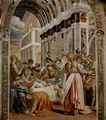Campi, Antonio
| Beruf: | Maler, Bildhauer, Illustrator |
| Geburtsort: | Cremona |
| Sterbedatum: | um 1591 |
| Wirkungszeitraum: | 2. Hälfte 16. Jh. |
| Wirkungsort: | Mailand, Piacenza, Mantua, Cremona |
Gemälde (1)
Grafiken (33)
Übersicht der vorhandenen Gemälde
- Abendmahl im Hause des Pharisäers, 1577, Cremona, San Sigismondo
Übersicht der vorhandenen Grafiken
- Illustration für Campis »Cremona fedelissima« [1], 1582–1584, Washington (D.C.), Library of Congress
- Illustration für Campis »Cremona fedelissima« [2], 1582–1584, Washington (D.C.), Library of Congress
- Illustration für Campis »Cremona fedelissima« [3], 1582–1584, Washington (D.C.), Library of Congress
- Illustration für Campis »Cremona fedelissima« [4], 1582–1584, Washington (D.C.), Library of Congress
- Illustration für Campis »Cremona fedelissima« [5], 1582–1584, Washington (D.C.), Library of Congress
- Illustration für Campis »Cremona fedelissima« [6], 1582–1584, Washington (D.C.), Library of Congress
- Illustration für Campis »Cremona fedelissima« [7], 1582–1584, Washington (D.C.), Library of Congress
- Illustration für Campis »Cremona fedelissima« [8], 1582–1584, Washington (D.C.), Library of Congress
- Illustration für Campis »Cremona fedelissima« [9], 1582–1584, Washington (D.C.), Library of Congress
- Illustration für Campis »Cremona fedelissima« [10], 1582–1584, Washington (D.C.), Library of Congress
- Illustration für Campis »Cremona fedelissima« [11], 1582–1584, Washington (D.C.), Library of Congress
- Illustration für Campis »Cremona fedelissima« [12], 1582–1584, Washington (D.C.), Library of Congress
- Illustration für Campis »Cremona fedelissima« [13], 1582–1584, Washington (D.C.), Library of Congress
- Illustration für Campis »Cremona fedelissima« [14], 1582, Washington (D.C.), Library of Congress
- Illustration für Campis »Cremona fedelissima« [15], 1582–1584, Washington (D.C.), Library of Congress
- Illustration für Campis »Cremona fedelissima« [16], 1582–1584, Washington (D.C.), Library of Congress
- Illustration für Campis »Cremona fedelissima« [17], 1582–1584, Washington (D.C.), Library of Congress
- Illustration für Campis »Cremona fedelissima« [18], 1582–1584, Washington (D.C.), Library of Congress
- Illustration für Campis »Cremona fedelissima« [19], 1582–1584, Washington (D.C.), Library of Congress
- Illustration für Campis »Cremona fedelissima« [20], 1582–1584, Washington (D.C.), Library of Congress
- Illustration für Campis »Cremona fedelissima« [21], 1582–1584, Washington (D.C.), Library of Congress
- Illustration für Campis »Cremona fedelissima« [22], 1582–1584, Washington (D.C.), Library of Congress
- Illustration für Campis »Cremona fedelissima« [23], 1582–1584, Washington (D.C.), Library of Congress
- Illustration für Campis »Cremona fedelissima« [24], 1582–1584, Washington (D.C.), Library of Congress
- Illustration für Campis »Cremona fedelissima« [25], 1582–1584, Washington (D.C.), Library of Congress
- Illustration für Campis »Cremona fedelissima« [26], 1582–1584, Washington (D.C.), Library of Congress
- Illustration für Campis »Cremona fedelissima« [27], 1582–1584, Washington (D.C.), Library of Congress
- Illustration für Campis »Cremona fedelissima« [28], 1582–1584, Washington (D.C.), Library of Congress
- Illustration für Campis »Cremona fedelissima« [29], 1582–1584, Washington (D.C.), Library of Congress
- Illustration für Campis »Cremona fedelissima« [30], 1582–1584, Washington (D.C.), Library of Congress
- Illustration für Campis »Cremona fedelissima« [31], 1582–1584, Washington (D.C.), Library of Congress
- Illustration für Campis »Cremona fedelissima« [32], 1582–1584, Washington (D.C.), Library of Congress
- Illustration für Campis »Cremona fedelissima« [33], 1582–1584, Washington (D.C.), Library of Congress
Buchempfehlung
Hoffmann, E. T. A.
Die Serapionsbrüder
Als Hoffmanns Verleger Reimer ihn 1818 zu einem dritten Erzählzyklus - nach den Fantasie- und den Nachtstücken - animiert, entscheidet sich der Autor, die Sammlung in eine Rahmenhandlung zu kleiden, die seiner Lebenswelt entlehnt ist. In den Jahren von 1814 bis 1818 traf sich E.T.A. Hoffmann regelmäßig mit literarischen Freunden, zu denen u.a. Fouqué und Chamisso gehörten, zu sogenannten Seraphinen-Abenden. Daraus entwickelt er die Serapionsbrüder, die sich gegenseitig als vermeintliche Autoren ihre Erzählungen vortragen und dabei dem serapiontischen Prinzip folgen, jede Form von Nachahmungspoetik und jeden sogenannten Realismus zu unterlassen, sondern allein das im Inneren des Künstlers geschaute Bild durch die Kunst der Poesie der Außenwelt zu zeigen. Der Zyklus enthält unter anderen diese Erzählungen: Rat Krespel, Die Fermate, Der Dichter und der Komponist, Ein Fragment aus dem Leben dreier Freunde, Der Artushof, Die Bergwerke zu Falun, Nußknacker und Mausekönig, Der Kampf der Sänger, Die Automate, Doge und Dogaresse, Meister Martin der Küfner und seine Gesellen, Das fremde Kind, Der unheimliche Gast, Das Fräulein von Scuderi, Spieler-Glück, Der Baron von B., Signor Formica
746 Seiten, 24.80 Euro
Im Buch blättern
Ansehen bei Amazon
Buchempfehlung
Romantische Geschichten III. Sieben Erzählungen
Romantik! Das ist auch – aber eben nicht nur – eine Epoche. Wenn wir heute etwas romantisch finden oder nennen, schwingt darin die Sehnsucht und die Leidenschaft der jungen Autoren, die seit dem Ausklang des 18. Jahrhundert ihre Gefühlswelt gegen die von der Aufklärung geforderte Vernunft verteidigt haben. So sind vor 200 Jahren wundervolle Erzählungen entstanden. Sie handeln von der Suche nach einer verlorengegangenen Welt des Wunderbaren, sind melancholisch oder mythisch oder märchenhaft, jedenfalls aber romantisch - damals wie heute. Nach den erfolgreichen beiden ersten Bänden hat Michael Holzinger sieben weitere Meistererzählungen der Romantik zu einen dritten Band zusammengefasst.
- Ludwig Tieck Peter Lebrecht
- Friedrich de la Motte Fouqué Undine
- Ludwig Achim von Arnim Isabella von Ägypten
- Clemens Brentano Geschichte vom braven Kasperl und dem schönen Annerl
- E. T. A. Hoffmann Das Fräulein von Scuderi
- Joseph von Eichendorff Aus dem Leben eines Taugenichts
- Wilhelm Hauff Phantasien im Bremer Ratskeller
456 Seiten, 16.80 Euro
Ansehen bei Amazon
- ZenoServer 4.030.014
- Nutzungsbedingungen
- Datenschutzerklärung
- Impressum



































